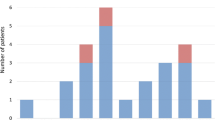Abstract
Purpose
The objective of this article was to present the case against screening people with neuro-urological disease for bladder cancer.
Methods
Literature around bladder cancer in neuro-urological patients (primarily spinal cord injured patients [SCI]) was identified.
Results
Bladder cancer is more common among patients with spinal cord injury, although the absolute risk is still low (between 0.3 and 0.6%). It is generally an aggressive disease, with atypical pathologic subtypes, and a high risk of mortality. It usually presents 15–30 years after SCI, and chronic inflammation of the bladder (due to catheters and urinary infections) may be risk factors. The debate about whether these patients should be screened for bladder cancer has persisted in the literature, and many physicians have justified a yearly cystoscopy as means of screening for bladder cancer. However, when examining the limited direct evidence of screening for bladder cancer, and the requirements for a screening test, it does not appear that bladder cancer screening is a rationale undertaking due to the low incidence, and unclear natural history. However, urologists should continue to be vigilant and appropriately investigate patients with high-risk symptoms such as hematuria, frequent UTIs, scrotal infection, or urethral discharge.
Conclusion
The current literature does not support screening patients with SCI for bladder cancer; however, physicians should have a high-evel of suspicion for symptoms suggestive of bladder cancer, and evaluate these at-risk patients promptly.
Similar content being viewed by others
Data availability
not applicable.
Code availability
not applicable.
References
Nyquist RH (1965) Morality in spinal cord injuries. Calif Med 103(6):417–419
Welk B, McIntyre A, Teasell R et al (2013) Bladder cancer in individuals with spinal cord injuries. Spinal Cord. https://doi.org/10.1038/sc.2013.33
Gui-Zhong L, Li-Bo M (2017) Bladder cancer in individuals with spinal cord injuries: a meta-analysis. Spinal Cord 55:341–345. https://doi.org/10.1038/sc.2016.151
Ismail S, Karsenty G, Chartier-Kastler E et al (2018) Prevalence, management, and prognosis of bladder cancer in patients with neurogenic bladder: a systematic review. Neurourol Urodynam 37:1386–1395. https://doi.org/10.1002/nau.23457
Groah SL, Weitzenkamp DA, Lammertse DP et al (2002) Excess risk of bladder cancer in spinal cord injury: evidence for an association between indwelling catheter use and bladder cancer. Arch Phys Med Rehabil 83:346–351
Kalisvaart JF, Katsumi HK, Ronningen LD, Hovey RM (2010) Bladder cancer in spinal cord injury patients. Spinal Cord 48:257–261. https://doi.org/10.1038/sc.2009.118
Ho C-H, Sung K-C, Lim S-W et al (2015) Chronic indwelling urinary catheter increase the risk of bladder cancer, even in patients without spinal cord injury. Medicine 94:e1736. https://doi.org/10.1097/md.0000000000001736
Böthig R, Tiburtius C, Schöps W et al (2021) Urinary bladder cancer as a late sequela of traumatic spinal cord injury. Mil Medical Res 8:29. https://doi.org/10.1186/s40779-021-00322-7
Savic G, DeVivo MJ, Frankel HL et al (2017) Causes of death after traumatic spinal cord injury—a 70-year British study. Spinal Cord 55:891–897. https://doi.org/10.1038/sc.2017.64
Nahm LS, Chen Y, DeVivo MJ, Lloyd LK (2015) Bladder cancer mortality after spinal cord injury over 4 decades. J Urol 193:1923–1928. https://doi.org/10.1016/j.juro.2015.01.070
Garnier S, Vendrell J, Boillot B et al (2020) Malignancy after augmentation enterocystoplasty: a nationwide study of natural history, prognosis and oncogene panel analysis. J Urol 204:136–143. https://doi.org/10.1097/ju.0000000000000752
Abol-enein H (2008) Infection: is it a cause of bladder cancer? Scand J Urol Nephrol Suppl. https://doi.org/10.1080/03008880802325309
Böthig R, Tiburtius C, Fiebag K et al (2020) Traumatic spinal cord injury confers bladder cancer risk to patients managed without permanent urinary catheterization: lessons from a comparison of clinical data with the national database. World J Urol 38:2827–2834. https://doi.org/10.1007/s00345-020-03077-3
Davies B, Chen JJ, McMurry T et al (2005) Efficacy of BTA stat, cytology, and survivin in bladder cancer surveillance over 5 years in patients with spinal cord injury. Urology 66:908–911. https://doi.org/10.1016/j.urology.2005.05.022
Stonehill WH, Goldman HB, Dmochowski RR (1997) The use of urine cytology for diagnosing bladder cancer in spinal cord injured patients. J Urol 157:2112–2114. https://doi.org/10.1016/s0022-5347(01)64688-3
Sammer U, Walter M, Knüpfer SC et al (2015) Do we need surveillance urethro-cystoscopy in patients with neurogenic lower urinary tract dysfunction? PLoS ONE 10:e0140970–e0140970. https://doi.org/10.1371/journal.pone.0140970
Yang C, Clowers D (1999) Screening cystoscopy in chronically catheterized spinal cord injury patients. Spinal Cord 37:204–207. https://doi.org/10.1038/sj.sc.3100767
Higuchi TT, Fox JA, Husmann DA (2011) Annual endoscopy and urine cytology for the surveillance of bladder tumors after enterocystoplasty for congenital bladder anomalies. J Urol 186:1791–1795. https://doi.org/10.1016/j.juro.2011.07.028
Hamid R, Greenwell TJ, Nethercliffe JM et al (2009) Routine surveillance cystoscopy for patients with augmentation and substitution cystoplasty for benign urological conditions: is it necessary? BJU Int 104:392–395. https://doi.org/10.1111/j.1464-410x.2009.08401.x
Dobrow MJ, Hagens V, Chafe R et al (2018) Consolidated principles for screening based on a systematic review and consensus process. Can Med Assoc J 190:E422–E429. https://doi.org/10.1503/cmaj.171154
El Masri y Masri WS, Patil S, Prasanna KV, Chowdhury JR (2013) To cystoscope or not to cystoscope patients with traumatic spinal cord injuries managed with indwelling urethral or suprapubic catheters? That is the question! Spinal Cord 52:49–53. https://doi.org/10.1038/sc.2013.119
Funding
none.
Author information
Authors and Affiliations
Contributions
BW was solely responsible for this work.
Corresponding author
Ethics declarations
Conflict of interest
none.
Ethical approval
not applicable.
Research involving human participants and/or animals
This work did not involve any work with animals or human participants.
Informed consent
not applicable.
Additional information
Publisher's Note
Springer Nature remains neutral with regard to jurisdictional claims in published maps and institutional affiliations.
Rights and permissions
About this article
Cite this article
Welk, B. The argument against screening for bladder cancer in neuro-urological patients. World J Urol 40, 1915–1919 (2022). https://doi.org/10.1007/s00345-021-03802-6
Received:
Accepted:
Published:
Issue Date:
DOI: https://doi.org/10.1007/s00345-021-03802-6




